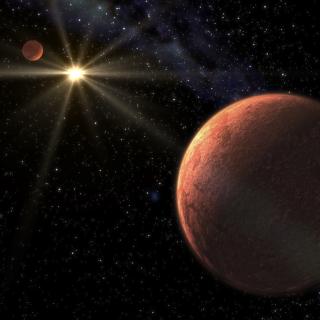Bibcode
Stangret, M.; Palle, E.; Esparza-Borges, E.; Orell Miquel, J.; Casasayas-Barris, N.; Zapatero Osorio, M. R.; Cristo, E.; Allart, R.; Alibert, Y.; Borsa, F.; Demangeon, O. D. S.; Di Marcantonio, P.; Ehrenreich, D.; Figueira, P.; González Hernández, J. I.; Herrero-Cisneros, E.; Martins, C. J. A. P.; Santos, N. C.; Seidel, J. V.; Azevedo Silva, T.; Sozzetti, A.; Steiner, M.; Suárez Mascareño, A.; Udry, S.
Bibliographical reference
Astronomy and Astrophysics
Advertised on:
11
2024
Journal
Citations
0
Refereed citations
0
Description
Thanks to their short orbital periods and hot extended atmospheres, hot Jupiters are ideal candidates for atmosphere studies with high- resolution spectroscopy. New stable spectrographs help improve our understanding of the evolution and composition of those types of planets. By analyzing two nights of observations using the ESPRESSO high-resolution spectrograph, we studied the architecture and atmosphere of hot Jupiter WASP-122b (KELT-14b). By analyzing the Rossiter-McLaughlin (RM) effect, we measured the spin-orbit angle of the system to be λ = 0.09‑0.90+0.88 deg. This result is in line with literature obliquity measurements of planetary systems around stars with effective temperatures cooler than 6500 K. Using the transmission spectroscopy, we studied the atmosphere of the planet. Applying both the single-line analysis and the cross-correlation method, we looked for Ca I, Cr I, FeH, Fe I, Fe II, H2O, Li I, Mg I, Na I, Ti I, TiO, V I, VO, and Y I. Our results show no evidence of any of these species in WASP-122b's atmosphere. The lack of significant detections can be explained by either the RM effect covering the regions where the atmospheric signal is expected and masking it, along with the low signal-to-noise ratio (S/N) of the observations or the absence of the relevant species in its atmosphere. ★Based on Guaranteed Time Observations collected at the European Southern Observatory under ESO program 106.21M2.004 by the ESPRESSO Consortium.
Related projects

Very Low Mass Stars, Brown Dwarfs and Planets
Our goal is to study the processes that lead to the formation of low mass stars, brown dwarfs and planets and to characterize the physical properties of these objects in various evolutionary stages. Low mass stars and brown dwarfs are likely the most numerous type of objects in our Galaxy but due to their low intrinsic luminosity they are not so
Rafael
Rebolo López

Exoplanets and Astrobiology
The search for life in the universe has been driven by recent discoveries of planets around other stars (known as exoplanets), becoming one of the most active fields in modern astrophysics. The growing number of new exoplanets discovered in recent years and the recent advance on the study of their atmospheres are not only providing new valuable
Enric
Pallé Bago